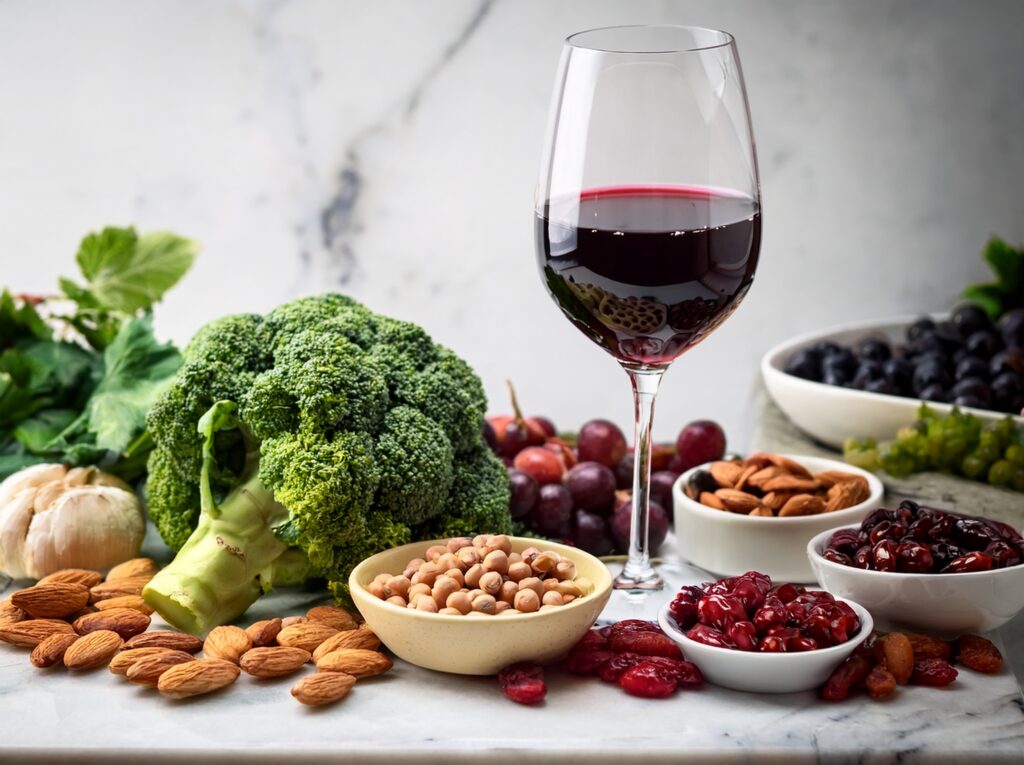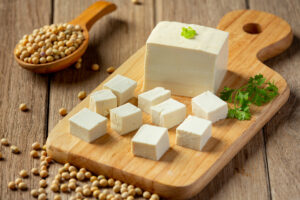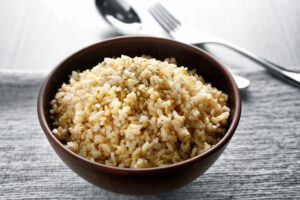Estrogen is a key hormone essential for reproductive health. It helps develop female sexual characteristics, regulates the menstrual cycle, supports bone strength, and contributes to overall well-being. While the body naturally produces estrogen, some foods contain phytoestrogens—plant-based compounds that mimic its effects.
These foods can help support hormonal balance, especially for those experiencing menopause, hormonal imbalances, or conditions related to low estrogen levels.
In this guide, we’ll explore the best sources of estrogen in food, how they work in the body, and why they matter for overall health.
Understanding Estrogen in Food
The estrogen found in foods isn’t the same as the estrogen produced by the body. Instead, these foods contain phytoestrogens—plant-based compounds that mimic estrogen’s effects. Phytoestrogens can interact with estrogen receptors, helping to either increase or decrease estrogenic activity depending on the hormone levels in the body.
There are four primary types of phytoestrogens:
- Isoflavones – Found in soy and legumes, these compounds have the strongest estrogenic effects.
- Lignans – Found in seeds, whole grains, and some fruits, lignans help support hormone balance.
- Coumestans – Found in alfalfa sprouts, clover, and some legumes, these have potent estrogen-like activity.
- Stilbenes – Found in grapes and red wine, resveratrol is the most well-known stilbene with mild estrogenic properties.
Now, let’s dive into the best food sources of estrogen.
Foods Rich in Estrogen
1. Soy and Soy-Based Foods
Soy is one of the richest sources of phytoestrogens, particularly isoflavones, which have estrogen-like properties.
Foods like tofu, soy milk, tempeh, and edamame are widely consumed for their ability to support hormonal health.
Research suggests that soy may help alleviate menopausal symptoms like hot flashes and support bone health by compensating for declining estrogen levels.
For example, a study tested soy germ extract (100 mg isoflavones) on women experiencing at least seven daily menopausal hot flushes. After 12 weeks, hot flushes decreased by 43.3% with soy and 30.8% with placebo. By 24 weeks, both groups saw a 68% reduction. Soy was most effective for severe symptoms and showed no hormonal safety concerns.
Similarly, a review of 18 studies found that taking 40–300 mg of soy isoflavones daily for 6–24 months helped slow down bone loss in menopausal women. It improved lumbar spine, femoral neck, and hip bone density, with effects varying by dose, supplement type, and menopause stage.
The structure of soybean isoflavones is similar to female sex hormones, allowing them to induce both estrogenic and antiestrogenic effects. This means they can provide estrogen-like effects or block stronger estrogen activity, depending on the body’s hormonal levels.
While some concerns exist about excessive soy consumption, moderate intake is generally considered beneficial for most people.
2. Flaxseeds
Flaxseeds are packed with lignans, a type of phytoestrogen that can influence estrogen metabolism in the body.
Although other foods like whole grains, sesame seeds offer lignans, flaxseeds contain upto 100 times more of these compounds.
These tiny seeds not only provide hormonal benefits, but are also rich in fiber and omega-3 fatty acids, which promote heart and digestive health.
A 2023 study gave menopausal women 1000 mg of flaxseed powder twice daily for six weeks. It significantly reduced hot flashes, vaginal dryness, bone pain, and night sweating but did not affect estrogen or progesterone. It also lowered oxidative stress and increased leptin without impacting BMI or blood pressure.
Leptin is a hormone that regulates appetite.
Additionally, a review suggests lignans mimic estrogen and may slow breast cancer cell growth. Animal studies indicate that flaxseed combined with tamoxifen reduces tumors. Some clinical trials also suggest it may lower breast cancer risk, especially in postmenopausal women.
3. Sesame Seeds
Like flaxseeds, sesame seeds contain lignans that can enhance estrogen activity in the body.
Sesame seeds are rich in calcium, vitamins, proteins, and healthy oils, making them beneficial for bone health.
A study tested phytoestrogens from sesame seeds on PCOS-induced rats, comparing them to a standard drug. Sesame’s ascorbic acid and thiamine helped regulate progesterone, estrogen, and testosterone while suppressing the PCOS-related MADH4 protein—without the immunotoxicity linked to the drug.
Not just sesame seeds—sesame oil may also support hormonal balance and ease menopausal symptoms.
For example, a study on postmenopausal osteoporosis in rats found that daily sesame oil supplementation improved bone mineral density, boosted bone formation markers, and reduced bone loss. It also helped maintain estrogen and aromatase levels, suggesting sesame oil may help protect against osteoporosis after menopause.
Regular consumption of sesame seeds or its oil may contribute to bone health and improved hormonal regulation.
4. Dried Fruits
Dried fruits, such as apricots, dates, prunes, and raisins are naturally high in phytoestrogens and can provide a concentrated source of these hormone-supporting compounds.
However, not all dried fruits contain phytoestrogens—apples, cranberries, figs, and peaches have been reported to have none.
Additionally, they are rich in fiber, antioxidants, and essential nutrients that promote overall health.
While they are a healthy snack option, it’s best to consume them in moderation (30-40 grams) due to their natural sugar content.
5. Cruciferous Vegetables
Cruciferous vegetables like broccoli, cabbage, Brussels sprouts, and cauliflower contain phytoestrogens, though in smaller amounts.
Broccoli, cauliflower, and white cabbage contains secoisolariciresinol, a lignan.
Brussels sprouts and broccoli sprouts contain coumestrol, a phytoestrogen that has estrogenic effects.
However, mature broccoli and cabbage do not contain detectable levels of coumestrol.
Adding cruciferous vegetables to your diet may help maintain a healthy estrogen balance while providing essential nutrients and antioxidants.
6. Nuts
Nuts contain phytoestrogens, mainly lignans and small amounts of isoflavones, with pistachios being the richest source.
While other nuts like walnuts, almonds, and cashews provide lignans, though in lower amounts than flaxseeds or sesame seeds.
Peanuts, technically legumes, contain isoflavones and stilbenes, two classes of phytoestrogens also found in soy and grapes.
While nuts are not the most potent estrogenic foods, they offer healthy fats, antioxidants, and plant compounds that support hormonal balance as part of a nutrient-rich diet.
Eating a handful of nuts daily can provide a steady source of plant-based estrogens along with other nutritional benefits like improved heart and brain health.
7. Red Grapes and Red Wine
Red grapes and red wine contain resveratrol, a phytoestrogen known for its antioxidant and anti-inflammatory properties. Other phytoestrogens in grapes include flavonoids, though they are not as prominent as resveratrol.
Red wine has higher resveratrol levels than white wine because it is fermented with grape skins for a longer period. While moderate red wine consumption may have some health benefits, excessive alcohol intake can have negative effects on hormonal balance.
Eating fresh red grapes can be a healthier alternative to obtain the benefits of resveratrol while also enjoying a dose of fiber and vitamins.
8. Alfalfa
Alfalfa is a lesser-known but potent source of phytoestrogens, primarily genistein, followed by kaempferol and coumestrol.
Genistein and kaempferol are flavonoids with estrogenic and antioxidant properties, while coumestrol is highly active in binding to estrogen receptors.
Alfalfa is commonly consumed as sprouts or supplements, but moderation is advised due to its strong hormonal effects. It also provides essential vitamins, minerals, and antioxidants for overall health.
9. Red Clover
Red clover is a rich source of phytoestrogens, primarily isoflavones such as genistein, daidzein, biochanin A, and formononetin.
A study on female mice found that red clover supplements improved endurance, muscle strength, and fat loss while boosting estrogen and progesterone levels. reduced fatigue-related compounds after exercise and increased beneficial bacteria in the gut, suggesting potential benefits for athletes.
Research suggests that red clover may help reduce menopausal symptoms such as hot flushes, night sweats, depression, and osteoporosis in postmenopausal women.
Commonly consumed as tea or supplements, red clover is considered a potent natural source of plant-based estrogens, though moderation is recommended due to its hormonal activity.
10. Berries
Berries like blueberries, raspberries, mulberries, and cranberries contain phytoestrogens, including flavonols, lignans, and resveratrol—a stilbene—which may help support hormonal balance.
Resveratrol has been studied for its potential role in mimicking estrogen and promoting heart health.
Packed with antioxidants, vitamins, and fiber, berries also help reduce inflammation and support overall well-being. Their natural sweetness makes them an easy, nutrient-rich addition to your diet.
11. Whole Grains
Whole grains like oats, barley, rye, and wheat contain phytoestrogens, particularly lignans, which are plant compounds that mimic estrogen in the body.
They also provide fiber, which aids in digestion and helps regulate blood sugar levels, indirectly supporting hormonal health. Moreover, whole grains can aid in weight management.
Swapping refined grains for whole grains in meals can help improve overall well-being while adding a steady source of plant-based estrogen.
12. Legumes
Though soybeans are the primary source, other legumes such as chickpeas, lentils, and peas are also good sources of phytoestrogens, including isoflavones and lignans, which may help support hormonal balance.
These plant-based proteins also provide fiber, vitamins, and minerals that contribute to overall health.
Regular consumption of legumes has been linked to improved heart health, healthy weight, and potential benefits for menopausal symptoms.
Incorporating these estrogen-rich foods into your diet can be a natural way to support hormonal balance, particularly for those experiencing estrogen fluctuations. However, balance is key—while phytoestrogens can be beneficial, excessive intake of any one food group may not always be ideal. A well-rounded diet that includes a variety of nutrient-dense foods will provide the best support for overall health.
For those dealing with hormonal imbalances, consulting a healthcare professional can help determine the best dietary and lifestyle adjustments.
Whether through soy, seeds, legumes, or vegetables, nature provides plenty of options to help maintain healthy estrogen levels and overall well-being.
References:
- Kim IS. Current Perspectives on the Beneficial Effects of Soybean Isoflavones and Their Metabolites for Humans. Antioxidants (Basel). 2021 Jun 30;10(7):1064. doi: 10.3390/antiox10071064. PMID: 34209224; PMCID: PMC8301030.
- Imhof M, Gocan A, Imhof M, Schmidt M. Soy germ extract alleviates menopausal hot flushes: placebo-controlled double-blind trial. Eur J Clin Nutr. 2018 Jul;72(7):961-970. doi: 10.1038/s41430-018-0173-3. Epub 2018 May 30. PMID: 29849181; PMCID: PMC6035149.
- Barańska A, Kanadys W, Bogdan M, Stępień E, Barczyński B, Kłak A, Augustynowicz A, Szajnik M, Religioni U. The Role of Soy Isoflavones in the Prevention of Bone Loss in Postmenopausal Women: A Systematic Review with Meta-Analysis of Randomized Controlled Trials. J Clin Med. 2022 Aug 10;11(16):4676. doi: 10.3390/jcm11164676. PMID: 36012916; PMCID: PMC9409780.
- Pabich M, Materska M. Biological Effect of Soy Isoflavones in the Prevention of Civilization Diseases. Nutrients. 2019 Jul 20;11(7):1660. doi: 10.3390/nu11071660. PMID: 31330799; PMCID: PMC6683102.
- Calado A, Neves PM, Santos T, Ravasco P. The Effect of Flaxseed in Breast Cancer: A Literature Review. Front Nutr. 2018 Feb 7;5:4. doi: 10.3389/fnut.2018.00004. PMID: 29468163; PMCID: PMC5808339.
- Kawa Dizaye et al. 2023. Effects of flaxseed (Linum usitatissimum) on climacteric symptoms and clinical parameters in post-menopausal women: Flaxseed effects on menopause associated symptoms and biochemical parameters. Iraqi Journal of Pharmaceutical Sciences . 32, 1 (Jun. 2023), 257–265. DOI:https://doi.org/10.31351/vol32iss1pp257-265.
- F. Haider, S. Riaz, R. Shakeel, K. Hafeez, U. Z. Qureshi, and R.- ur- Rehman, “Investigation of Phytoestrogens Found in Sesame Seeds via Computational and Translational Approaches”, BioSci Rev., vol. 5, no. 4, pp. 53-68, Nov. 2023.
- Hsu CC, Ko PY, Kwan TH, Liu MY, Jou IM, Lin CW, Wu PT. Daily supplement of sesame oil prevents postmenopausal osteoporosis via maintaining serum estrogen and aromatase levels in rats. Sci Rep. 2024 Jan 3;14(1):321. doi: 10.1038/s41598-023-50453-1. PMID: 38172141; PMCID: PMC10764805.
- Alasalvar C, Chang SK, Kris-Etherton PM, Sullivan VK, Petersen KS, Guasch-Ferré M, Jenkins DJA. Dried Fruits: Bioactives, Effects on Gut Microbiota, and Possible Health Benefits-An Update. Nutrients. 2023 Mar 26;15(7):1611. doi: 10.3390/nu15071611. PMID: 37049451; PMCID: PMC10097306.
- Durazzo A, Lucarini M, Camilli E, Marconi S, Gabrielli P, Lisciani S, Gambelli L, Aguzzi A, Novellino E, Santini A, Turrini A, Marletta L. Dietary Lignans: Definition, Description and Research Trends in Databases Development. Molecules. 2018 Dec 8;23(12):3251. doi: 10.3390/molecules23123251. PMID: 30544820; PMCID: PMC6321438.
- Ohta T, Uto T, Tanaka H. Effective methods for increasing coumestrol in soybean sprouts. PLoS One. 2021 Nov 18;16(11):e0260147. doi: 10.1371/journal.pone.0260147. PMID: 34793574; PMCID: PMC8601530.
- Ali Dini*. Health Benefits of Pistachios: A Mini-Review. Nov Tech Nutri Food Sci. 7(5). NTNF. 000671. 2024.
DOI: 10.31031/NTNF.2024.07.000671. - Xuan C, Zhao C, Zhou TT, Guo JJ, Pan D, Wang ZB, He GW. Associations of urinary phytoestrogens with all-cause and cardiovascular mortality in adults: a population-based cohort study. Front Endocrinol (Lausanne). 2024 Sep 10;15:1400182. doi: 10.3389/fendo.2024.1400182. PMID: 39319255; PMCID: PMC11419972.
- Chukwumah Y, Walker LT, Verghese M. Peanut skin color: a biomarker for total polyphenolic content and antioxidative capacities of peanut cultivars. Int J Mol Sci. 2009 Nov 11;10(11):4941-4952. doi: 10.3390/ijms10114941. PMID: 20087468; PMCID: PMC2808014.
- Lephart ED. Phytoestrogens (Resveratrol and Equol) for Estrogen-Deficient Skin-Controversies/Misinformation versus Anti-Aging In Vitro and Clinical Evidence via Nutraceutical-Cosmetics. Int J Mol Sci. 2021 Oct 18;22(20):11218. doi: 10.3390/ijms222011218. PMID: 34681876; PMCID: PMC8538984.
- Tucak, M.; Čupić, T.; Horvat, D.; Popović, S.; Krizmanić, G.; Ravlić, M. Variation of Phytoestrogen Content and Major Agronomic Traits in Alfalfa (Medicago sativa L.). Populations. Agronomy 2020, 10, 87. https://doi.org/10.3390/agronomy10010087.
- Chen YM, Wang IL, Zhu XY, Chiu WC, Chiu YS. Red Clover Isoflavones Influence Estradiol Concentration, Exercise Performance, and Gut Microbiota in Female Mice. Front Nutr. 2021 Apr 14;8:623698. doi: 10.3389/fnut.2021.623698. PMID: 33937304; PMCID: PMC8079722.
- Otun J, Sahebkar A, Östlundh L, Atkin SL, Sathyapalan T. Systematic Review and Meta-analysis on the Effect of Soy on Thyroid Function. Sci Rep. 2019 Mar 8;9(1):3964. doi: 10.1038/s41598-019-40647-x. PMID: 30850697; PMCID: PMC6408586.
- Mauny A, Faure S, Derbré S. Phytoestrogens and Breast Cancer: Should French Recommendations Evolve? Cancers (Basel). 2022 Dec 14;14(24):6163. doi: 10.3390/cancers14246163. PMID: 36551648; PMCID: PMC9776930.
- Domínguez-López I, Yago-Aragón M, Salas-Huetos A, Tresserra-Rimbau A, Hurtado-Barroso S. Effects of Dietary Phytoestrogens on Hormones throughout a Human Lifespan: A Review. Nutrients. 2020 Aug 15;12(8):2456. doi: 10.3390/nu12082456. PMID: 32824177; PMCID: PMC7468963.
Note: References above are used under open-access licenses CC BY 3.0 and CC BY 4.0.





